
Photographed by Matthew G. Hunter ..... Date: 7/21/95 ..... Photo: AAG-001
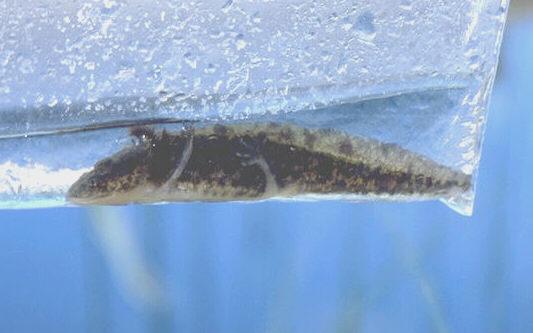
Photographed by Matthew G. Hunter ..... Date: 7/21/95 ..... Photo: AAG-002

This larva is about one year old.
Photographed by Matthew G. Hunter ..... Date: 7/21/95 ..... Photo: AAG-003

Photographed by Matthew G. Hunter ..... Date: 8/7/95 ..... Photo: AAG-004

This group of larvae were hatched within a few months prior to the photograph.
Photographed by Matthew G. Hunter ..... Date: 8/7/95 ..... Photo: AAG-005

This metamorphosed individual shows the marbling pattern common to this species. A few metamorphosed individuals do not show this pattern.
Photographed by Matthew G. Hunter ..... Date: 6/24/95 ..... Photo: AAG-006

Photographed by Matthew G. Hunter ..... Date: 8/23/95 ..... Photo: AAG-007

The gills and tail fin can be seen on this medium-sized larva. The dull, brown, suttle mottled pattern is common in larvae of this species. Some show more striking mottling, and some are nearly solid colored.
Photographed by Matthew G. Hunter ..... Date: 8/24/95 ..... Photo: AAG-008

Photographed by Matthew G. Hunter ..... Date: 8/25/95 ..... Photo: AAG-009

Photographed by Matthew G. Hunter ..... Date: 9/2/95 ..... Photo: AAG-010
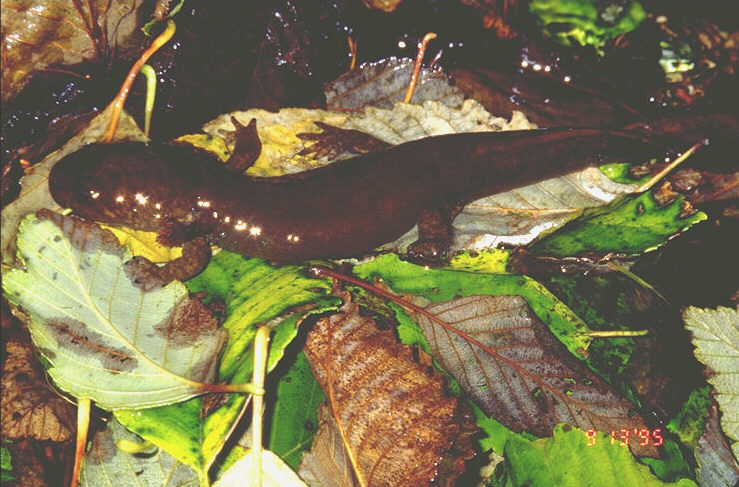
Photographed by Matthew G. Hunter ..... Date: 9/13/95 ..... Photo: AAG-011
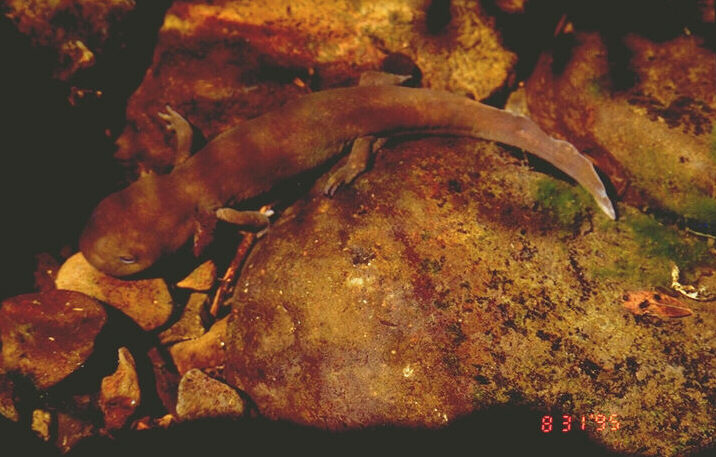
Most Pacific giant salamanders grow for 1-3 years before metamorphosing. Some individuals do not metamorphose, but become reproductively mature while retaining larval characteristics. These individuals are called neotenes. This individual is about 240 mm in total length, and is most likely neotenic.
Photographed by Matthew G. Hunter ..... Date: 8/31/95 ..... Photo: AAG-012
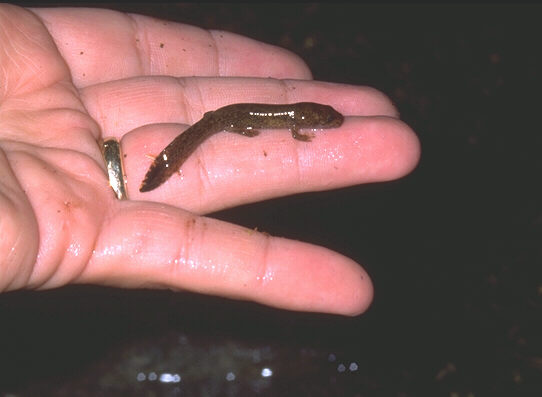
This small larva hatched from an egg less than a year prior to this photo. It will grow for one or two years more before metamorphosing, or becoming neotenic.
Photographed by Matthew G. Hunter ..... Date: 6/24/95 ..... Photo: AAG-013
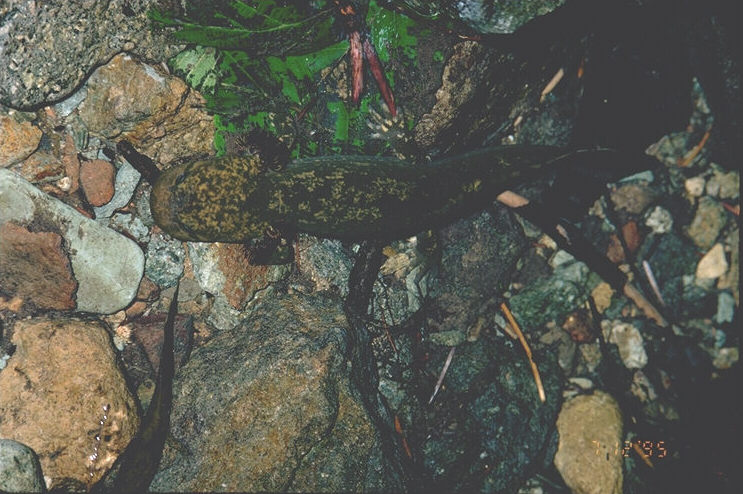
Photographed by Matthew G. Hunter ..... Date: 7/12/95 ..... Photo: AAG-014
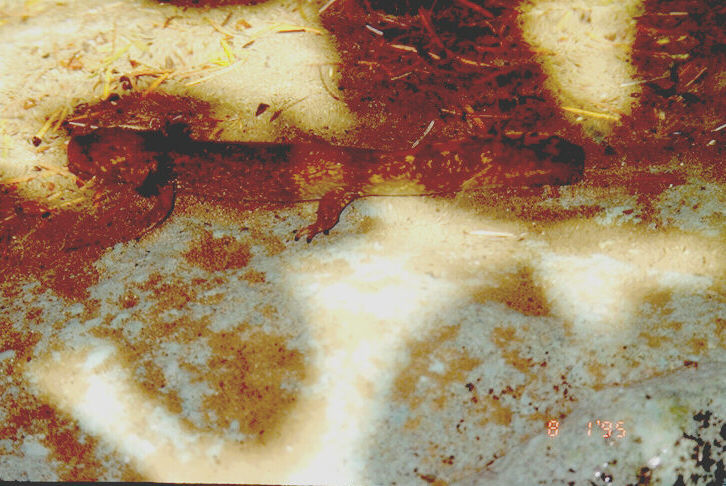
Photographed by Matthew G. Hunter ..... Date: 8/1/95 ..... Photo: AAG-015
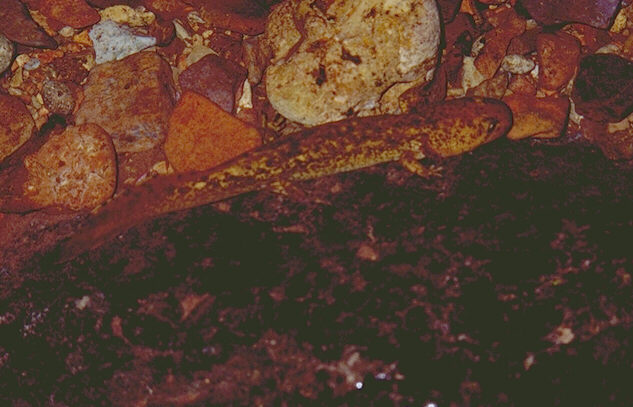
Photographed by Matthew G. Hunter ..... Date: 9/2/95 ..... Photo: AAG-016

Torrent salamanders grow as larvae for 3 or more years before metamorphosing. This set of larvae show three sizes that likely represent three age classes.
Photographed by Matthew G. Hunter ..... Date: 9/16/95 ..... Photo: AAG-017

This group of torrent salamanders are all at maximum reported sizes for larvae of this species. Note the smooth lemon-yellow coloration underneath, only slight spotting on the lower sides, and the reddish gills between the head and front legs.
Photographed by Matthew G. Hunter ..... Date: 9/14/95 ..... Photo: AAG-018
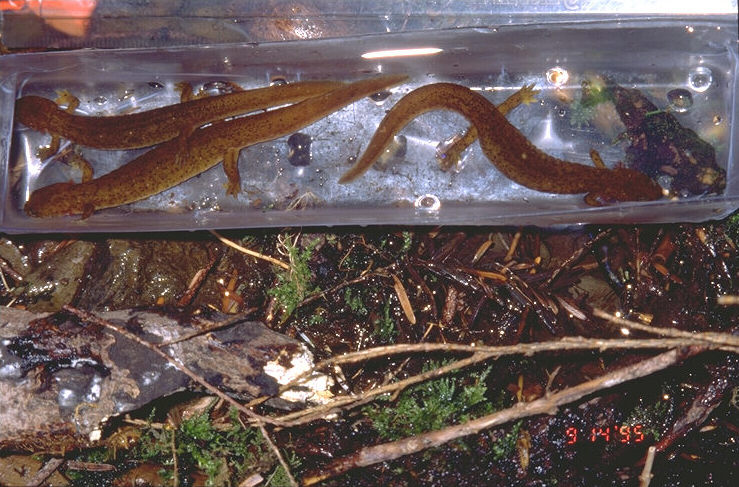
These individuals are the same as those in photo 18. Note the dull brown sand-grain pattern on top, and the stout, attenuated tail.
Photographed by Matthew G. Hunter ..... Date: 9/14/95 ..... Photo: AAG-019
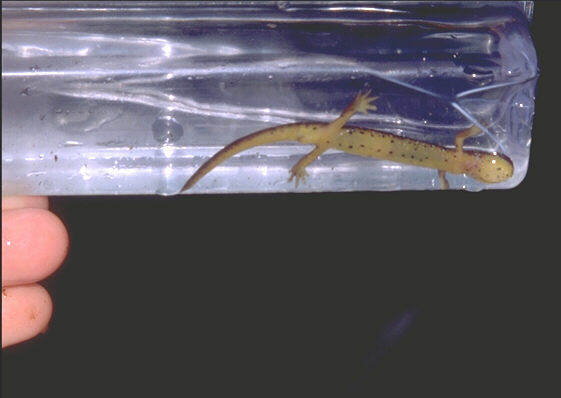
The underside of this adult shows the characteristic spotted pattern of the Cascade torrent salamander. The spotting can be even more heavy than this.
Photographed by Matthew G. Hunter ..... Date: 8/23/95 ..... Photo: AAG-020

Photographed by Matthew G. Hunter ..... Date: 8/23/95 ..... Photo: AAG-021
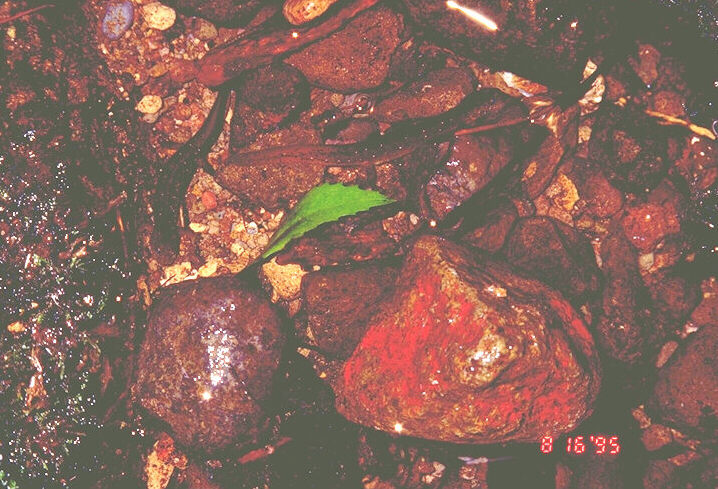
Photographed by Matthew G. Hunter ..... Date: 8/16/95 ..... Photo: AAG-022
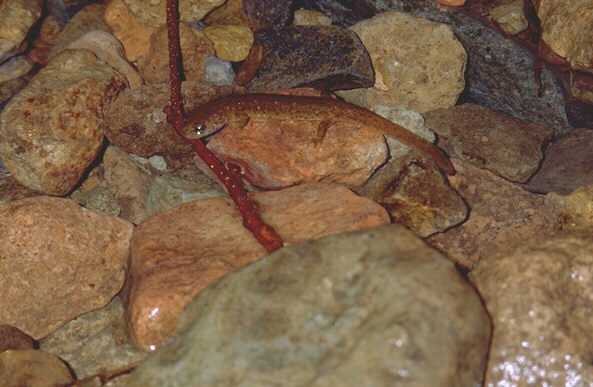
This larvae is shown in typical pebble and cobble substrate with abundant interstitial space.
Photographed by Matthew G. Hunter ..... Date: 9/11/95 ..... Photo: AAG-023
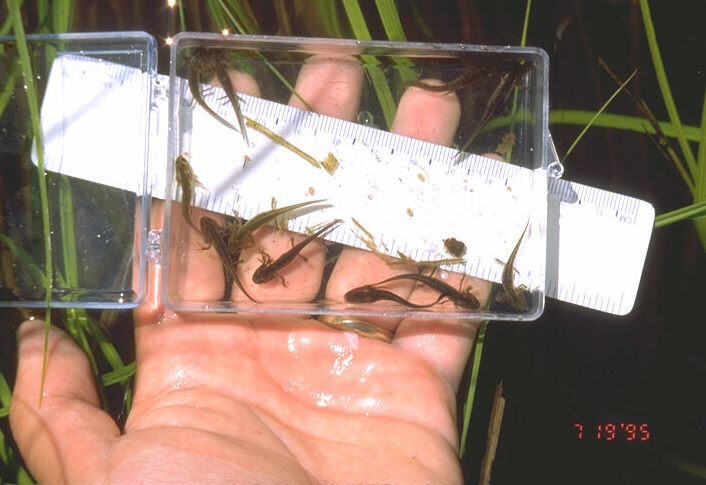
This group of larvae were hatched from eggs within a few months prior to this photo.
Photographed by Matthew G. Hunter ..... Date: 7/19/95 ..... Photo: AAG-024
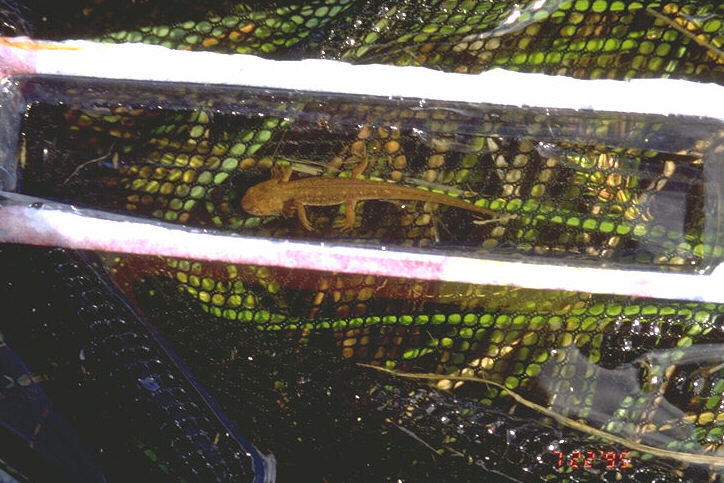
Photographed by Matthew G. Hunter ..... Date: 7/22/95 ..... Photo: AAG-025
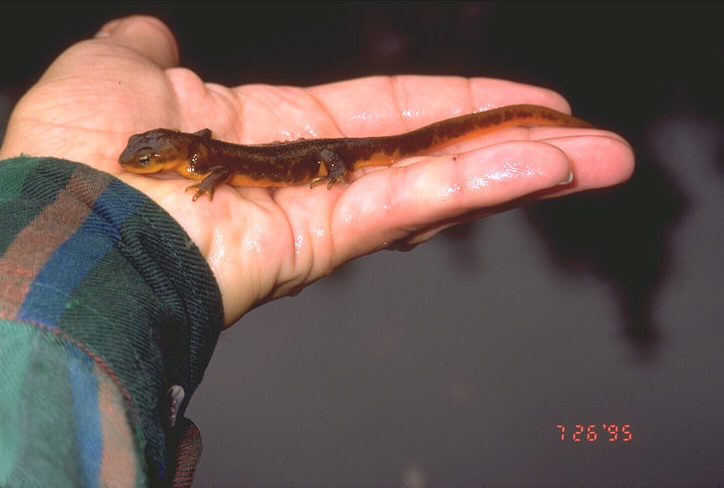
This individual shows a mottled pattern that is uncommon in most populations.
Photographed by Matthew G. Hunter ..... Date: 7/26/95 ..... Photo: AAG-026
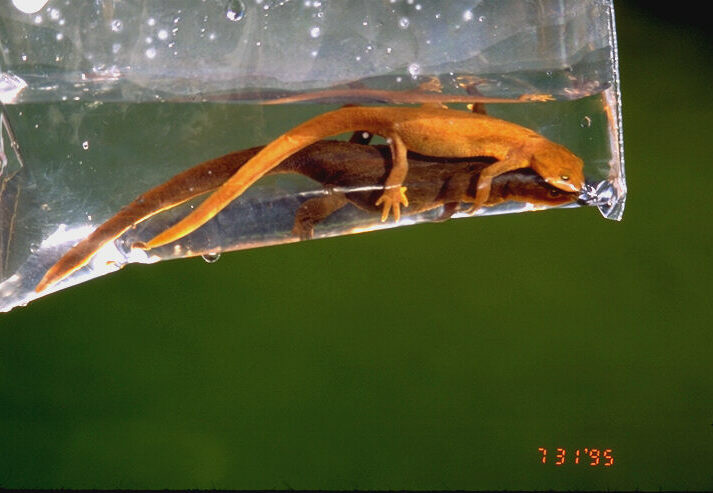
Photographed by Matthew G. Hunter ..... Date: 7/31/95 ..... Photo: AAG-027
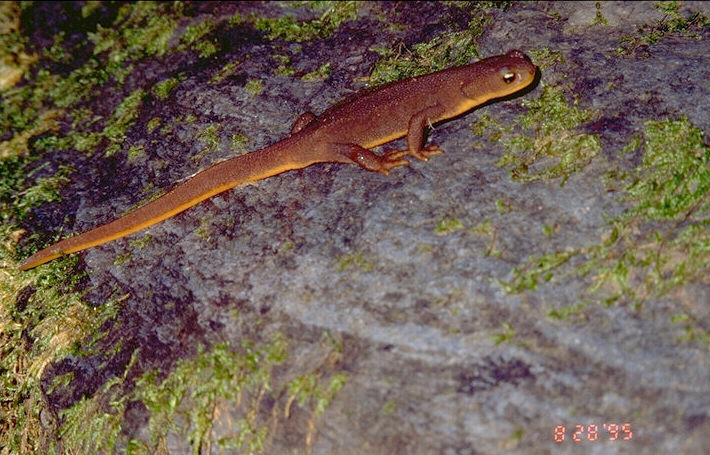
After breeding in ponds or metamorphosing, these newts may travel up to several kilometers from their breeding ponds.
Photographed by Matthew G. Hunter ..... Date: 8/28/95 ..... Photo: AAG-028

These salamanders are most often found along streams or seeps.
Photographed by Matthew G. Hunter ..... Date: 9/12/95 ..... Photo: AAG-029

Photographed by Matthew G. Hunter ..... Date: 9/12/95 ..... Photo: AAG-030
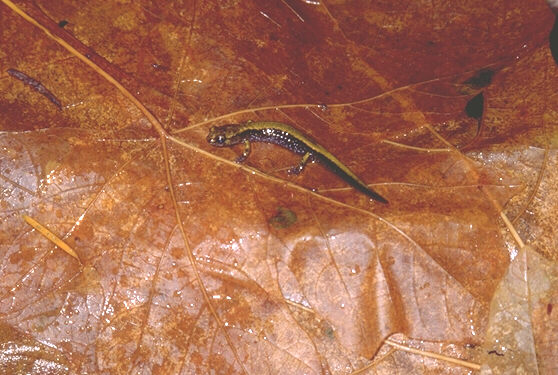
This juvenile shows a much more solid dorsal stripe than adults do. Individuals of this size are very difficult to distinguish from yellow-backed forms of the western redbacked salamander.
Photographed by Matthew G. Hunter ..... Date: 11/9/95 ..... Photo: AAG-031
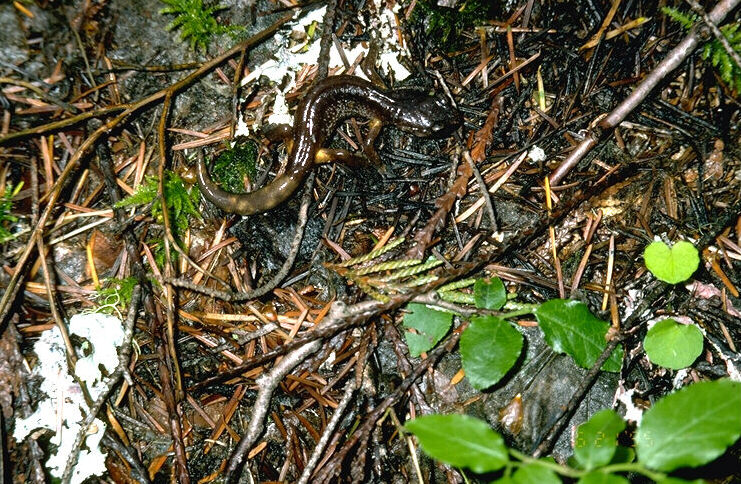
This individual is dark and has numerous pale spots on its sides. The swollen tail and constricted base characteristic of this species can be seen.
Photographed by Matthew G. Hunter ..... Date: 6/21/95 ..... Photo: AAG-032

This adult shows the typical rust-orange color of most adults in this area. The constricted base of the tail characteristic of this species can be seen.
Photographed by Matthew G. Hunter ..... Date: 10/3/95 ..... Photo: AAG-033

Photographed by Matthew G. Hunter ..... Date: 10/3/95 ..... Photo: AAG-034
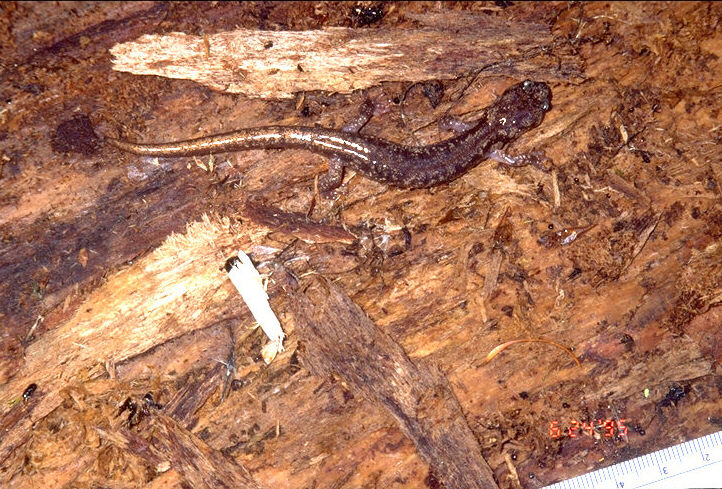
This species is commonly found under loose bark of rotted logs as shown here.
Photographed by Matthew G. Hunter ..... Date: 6/24/95 ..... Photo: AAG-035

This species is sometimes found deep in logs in ant and termite tunnels.
Photographed by Matthew G. Hunter ..... Date: 6/24/95 ..... Photo: AAG-036

Photographed by Matthew G. Hunter ..... Date: 8/22/95 ..... Photo: AAG-037

Photographed by Matthew G. Hunter ..... Date: 10/3/95 ..... Photo: AAG-038
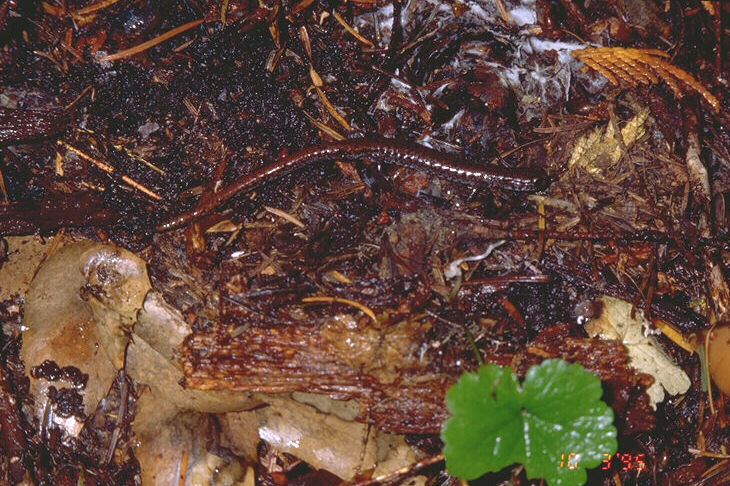
This slender salamander blends well with the redding needles and bark of the forest floor. It is most often found under surface material in spring and inside rotted logs.
Photographed by Matthew G. Hunter ..... Date: 10/3/95 ..... Photo: AAG-039
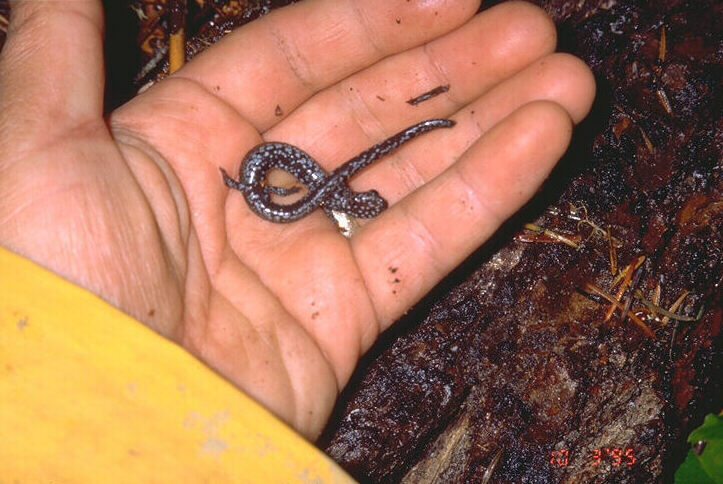
The underside is a striking contrast of black with many white stars scattered throughout.
Photographed by Matthew G. Hunter ..... Date: 8/31/95 ..... Photo: AAG-040

Photographed by Matthew G. Hunter ..... Date: 8/31/95 ..... Photo: AAG-041
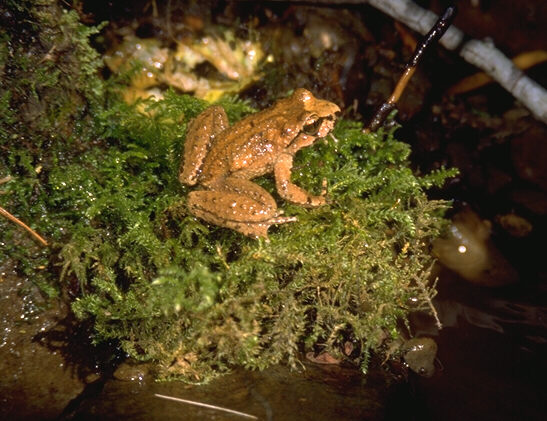
Tailed frogs vary tremendously in color. This tan individual in one of few in this area.
Photographed by Matthew G. Hunter ..... Date: 9/14/95 ..... Photo: AAG-042

While most tailed frog tadpoles are solid black with a white tip to the tail, a few individuals show this more pale, mottled pattern.
Photographed by Matthew G. Hunter ..... Date: 8/10/95 ..... Photo: AAG-043

Photographed by Matthew G. Hunter ..... Date: 8/16/95 ..... Photo: AAG-044

Photographed by Matthew G. Hunter ..... Date: 8/24/95 ..... Photo: AAG-045
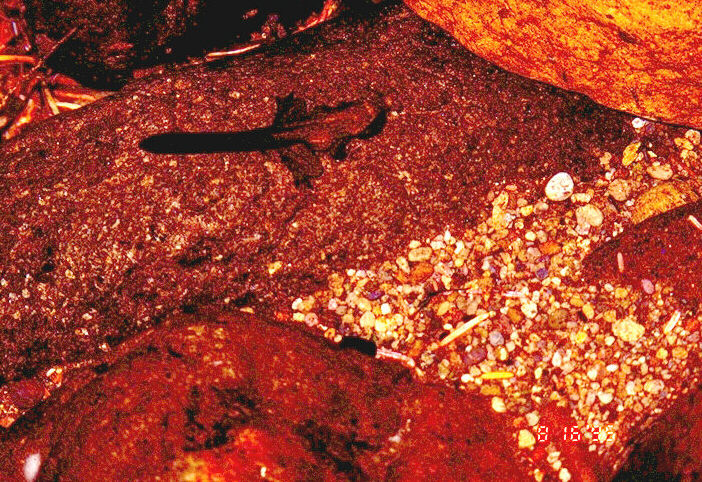
Photographed by Matthew G. Hunter ..... Date: 8/16/95 ..... Photo: AAG-046
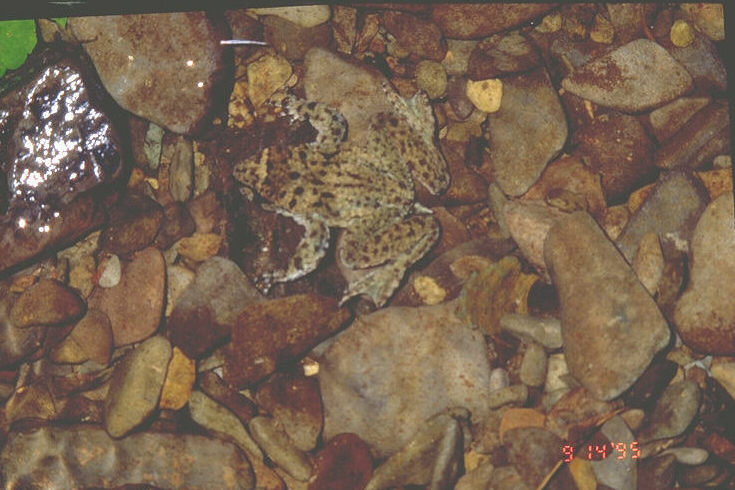
Individual tailed frogs can change their color or pattern to some degree. This individual is currently showing a rather spotted pattern.
Photographed by Matthew G. Hunter ..... Date: 9/14/95 ..... Photo: AAG-047

Photographed by Matthew G. Hunter ..... Date: 9/6/95 ..... Photo: AAG-048
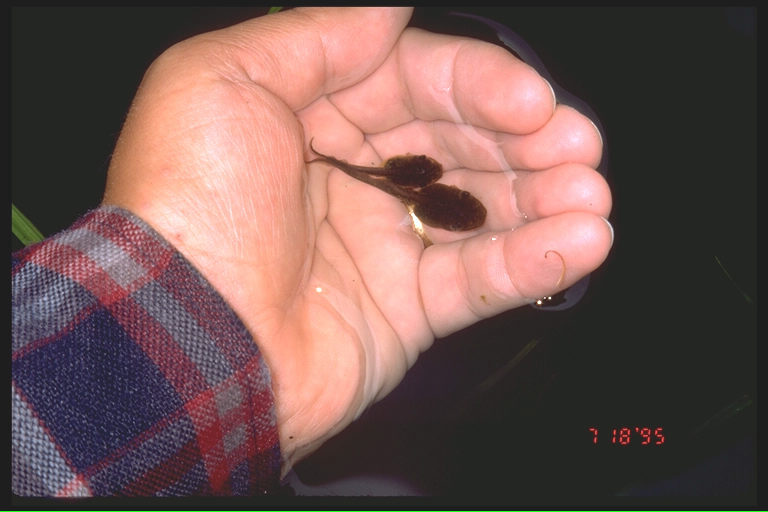
Treefrog tadpoles are distinguished from Rana species by the placement of the eyes. Here you can see the eyes near the boarder of the head, breaking the head outline. Eyes of the Cascade and red-legged frog tadpoles are set in from the head margin when viewed from above.
Photographed by Matthew G. Hunter ..... Date: 7/18/95 ..... Photo: AAG-049

Photographed by Matthew G. Hunter ..... Date: 7/19/95 ..... Photo: AAG-050

Photographed by Matthew G. Hunter ..... Date: 8/18/95 ..... Photo: AAG-051
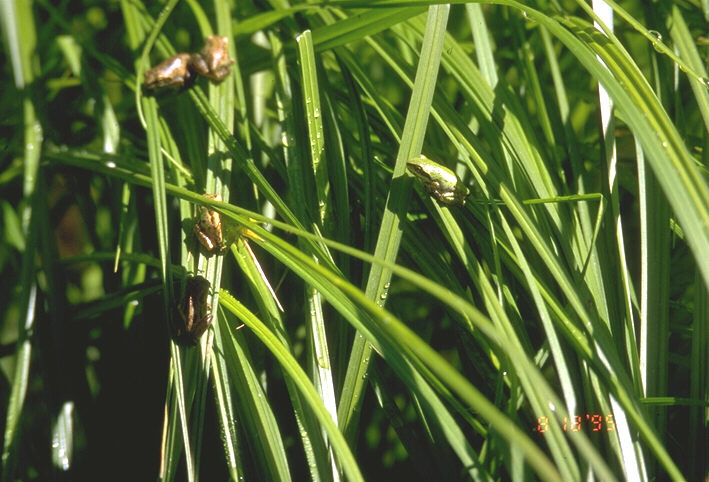
These froglets, some still with small tails, are escaping the pond habitat, and possible predators, by climbing up these sedge stalks at the edge of the pond. Soon they will make a trek away from the pond toward an uncertain future.
Photographed by Matthew G. Hunter ..... Date: 8/18/95 ..... Photo: AAG-052

The mottled groin and red undersides of the legs typical of this species are hidden as this frog floats on the surface of the pond. The dark earpatch, and pale lip-line below and behind the eye help to identify the frog.
Photographed by Matthew G. Hunter ..... Date: 7/18/95 ..... Photo: AAG-053

This adult-sized frog was coaxed out of the water. They normally escape a perceived threat by swimming down into tangles of live and dead vegetation at stream and pond edges and bottoms.
Photographed by Matthew G. Hunter ..... Date: 8/18/95 ..... Photo: AAG-054
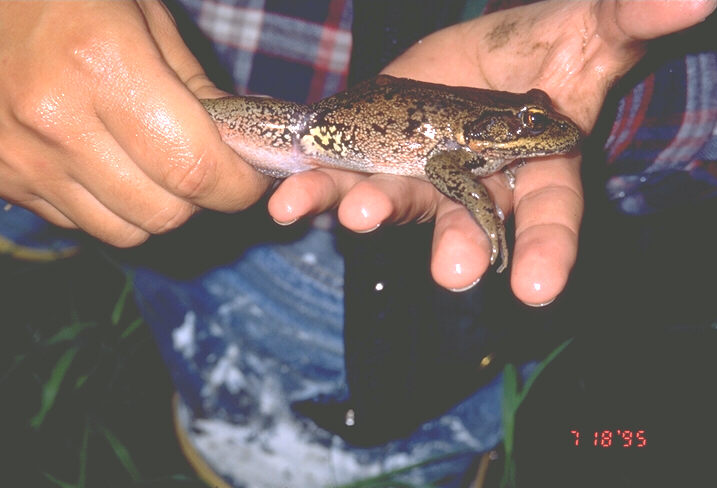
With the legs pulled back, the beautiful mottling can be seen on the flank of this adult-sized frog.
Photographed by Lisa L. Hunter ..... Date: 7/18/95 ..... Photo: AAG-055
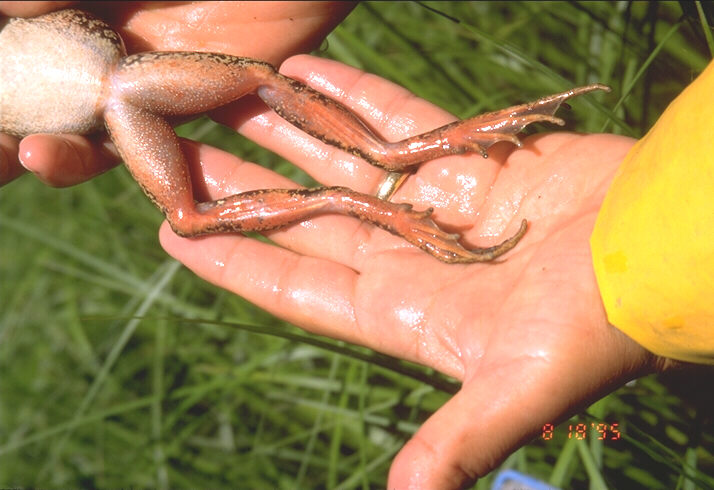
With the frog turned over, the bright red color of the underside of the legs can be seen on this adult-sized frog.
Photographed by Lisa L. Hunter ..... Date: 8/18/95 ..... Photo: AAG-056
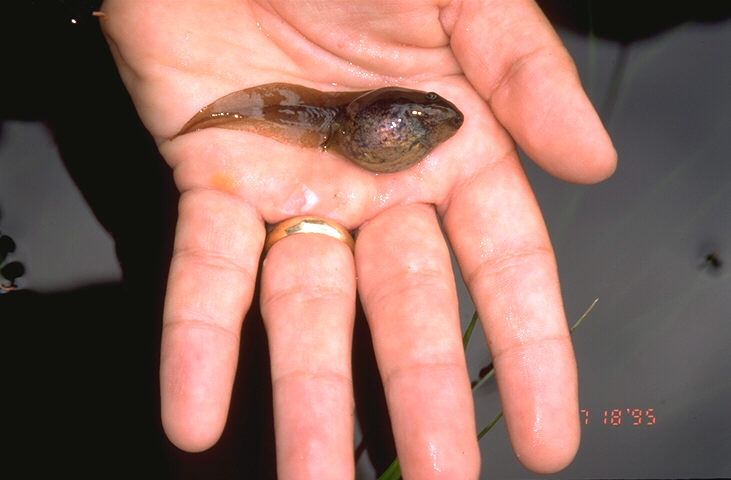
This tadpole shows the typical reddish and brassy color on the undersides, and a relatively short, tall tail with little spotting.
Photographed by Matthew G. Hunter ..... Date: 7/18/95 ..... Photo: AAG-057

This tadpole shows the relatively long tail, not as tall as the red-legged frog, and with more spotting.
Photographed by Matthew G. Hunter ..... Date: 7/26/95 ..... Photo: AAG-058
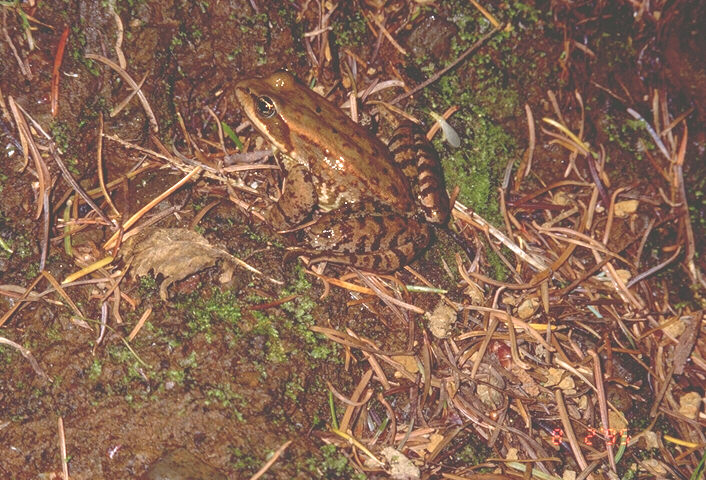
This frog was found along a high elevation stream in a clearcut-meadow complex, as is typical for this species.
Photographed by Matthew G. Hunter ..... Date: 8/2/95 ..... Photo: AAG-059

Photographed by Matthew G. Hunter ..... Date: 8/31/95 ..... Photo: AAG-060

This juvenile Cascade frog shows the typical honey or caramel colored undersides of the legs, and the variable spotting pattern under the chest and head.
Photographed by Matthew G. Hunter ..... Date: 9/1/95 ..... Photo: AAG-061

Photographed by Matthew G. Hunter ..... Date: 9/1/95 ..... Photo: AAG-062
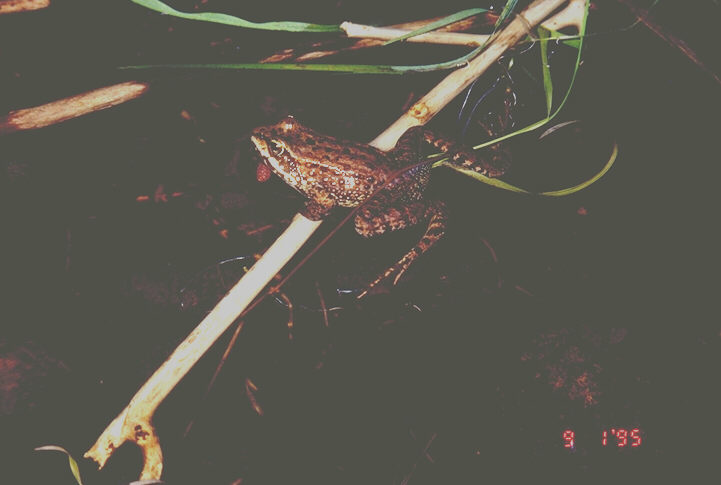
Photographed by Matthew G. Hunter ..... Date: 9/1/95 ..... Photo: AAG-063
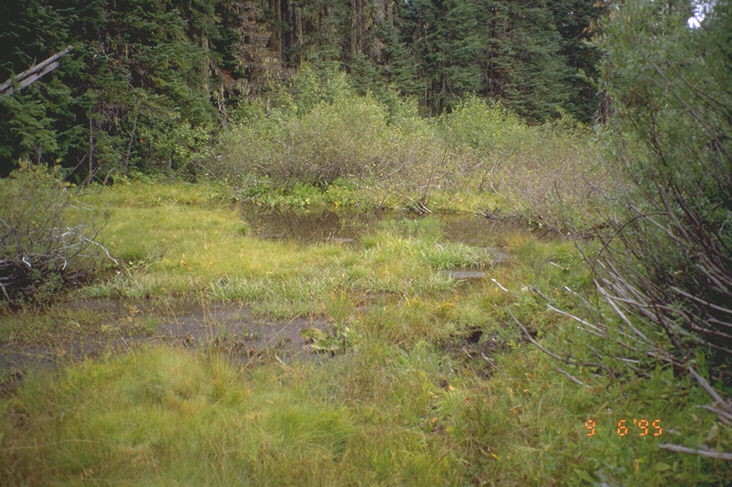
In the western Cascades, breeding ponds of Cascade frogs are often in small ponds or puddles in high elevation herbaceous meadows. Some of these ponds, including the one pictured here are also used heavily by elk.
Photographed by Matthew G. Hunter ..... Date: 9/6/95 ..... Photo: AAG-064

This large adult female was found soaking up warmth from the gravel road. This habit, common to other snakes as well, makes them unfortunately vulnerable to road traffic.
Photographed by Matthew G. Hunter ..... Date: 7/12/95 ..... Photo: AAG-065

What might look like a head is actually the end of this snake's tail, peaking over its body. The head is actually to the left and behind its body.
Photographed by Matthew G. Hunter ..... Date: 7/12/95 ..... Photo: AAG-066
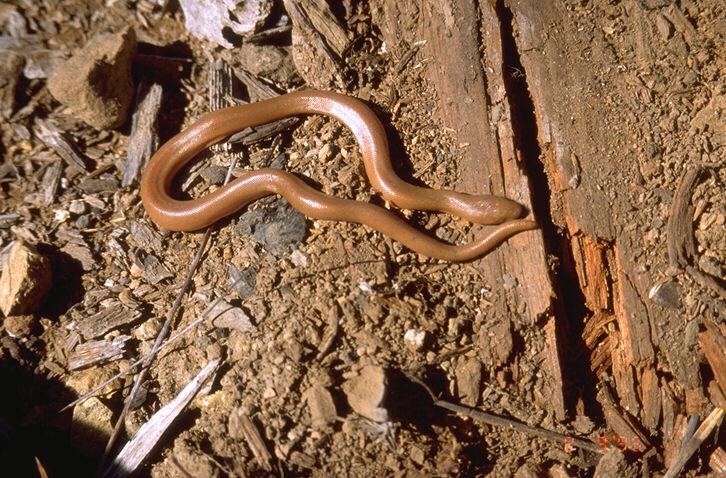
Photographed by Matthew G. Hunter ..... Date: 8/9/95 ..... Photo: AAG-067

Photographed by Matthew G. Hunter ..... Date: 8/3/95 ..... Photo: AAG-068

These are small but beautiful snakes. The orange color is brightest and deepest towards the end of the tail, shown curled up here.
Photographed by Matthew G. Hunter ..... Date: 8/3/95 ..... Photo: AAG-069
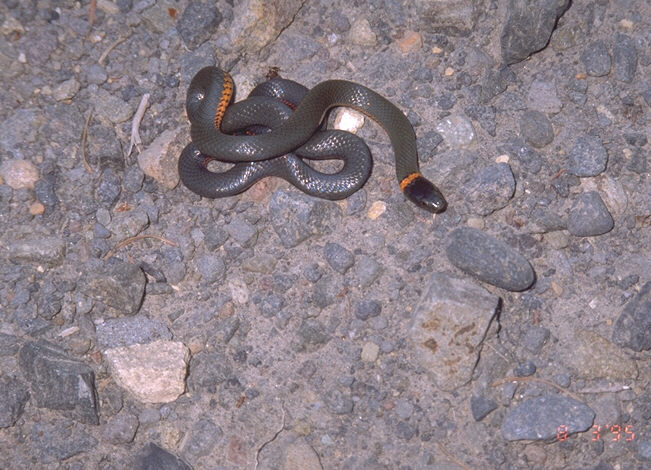
This species is uncommon at this location in the Cascades. It is more common and locally very common at lower elevations to the west, such as in the Willamette Valley.
Photographed by Matthew G. Hunter ..... Date: 8/3/95 ..... Photo: AAG-070
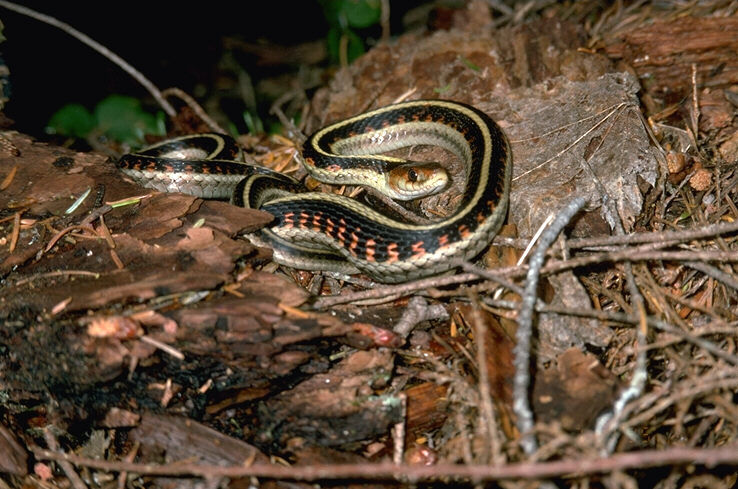
This snake was found digesting a prey item. A slight bulge can be seen at mid-body in the foreground. The sharp demarcation of pattern and the ladder-like orange spotting along the sides are consistent field marks of this species.
Photographed by Matthew G. Hunter ..... Date: 7/7/95 ..... Photo: AAG-071

This small individual is attempting to (and successfully did) swallow a captured Pacific treefrog tadpole tail first. This species of garter snake was often seen in pond habitats where frog tadpoles of any kind were present.
Photographed by Matthew G. Hunter ..... Date: 7/18/95 ..... Photo: AAG-072

Photographed by Matthew G. Hunter ..... Date: 8/13/95 ..... Photo: AAG-073
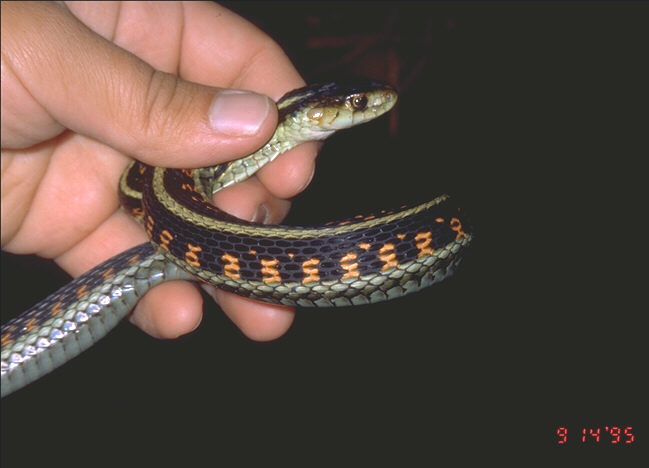
Photographed by Matthew G. Hunter ..... Date: 9/14/95 ..... Photo: AAG-074

Looking like blood, the red spots on the underside of this garter snake are one of the many characteristics that very greatly in this species.
Photographed by Matthew G. Hunter ..... Date: 6/24/95 ..... Photo: AAG-075

This individual shows a fairly uniform pattern of small spots on top, and stripes are difficult to discern.
Photographed by Matthew G. Hunter ..... Date: 7/5/95 ..... Photo: AAG-076
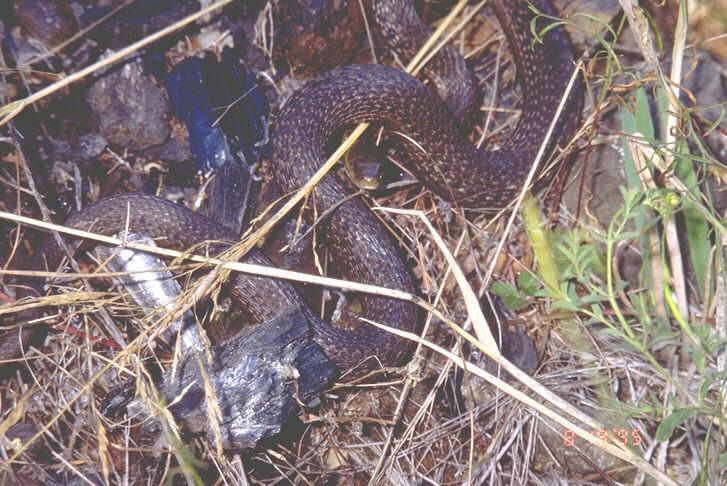
Photographed by Matthew G. Hunter ..... Date: 8/18/95 ..... Photo: AAG-077
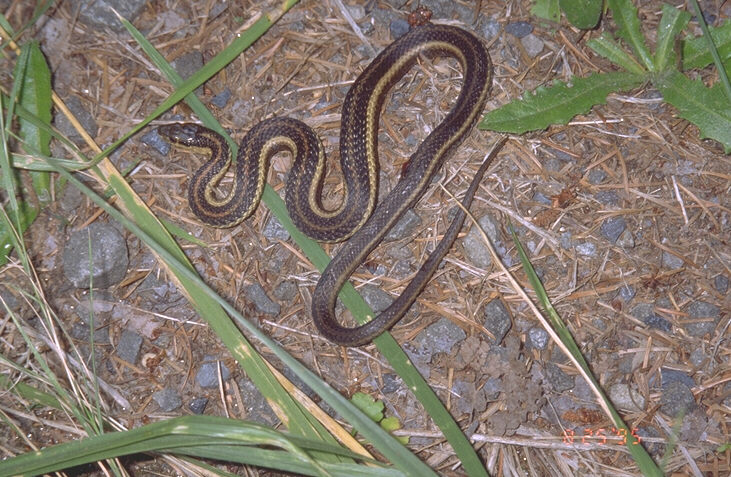
Photographed by Matthew G. Hunter ..... Date: 8/25/95 ..... Photo: AAG-078

This is a very tan individual and its patterns consist of solid colors void of any strong spotting.
Photographed by Matthew G. Hunter ..... Date: 8/31/95 ..... Photo: AAG-079
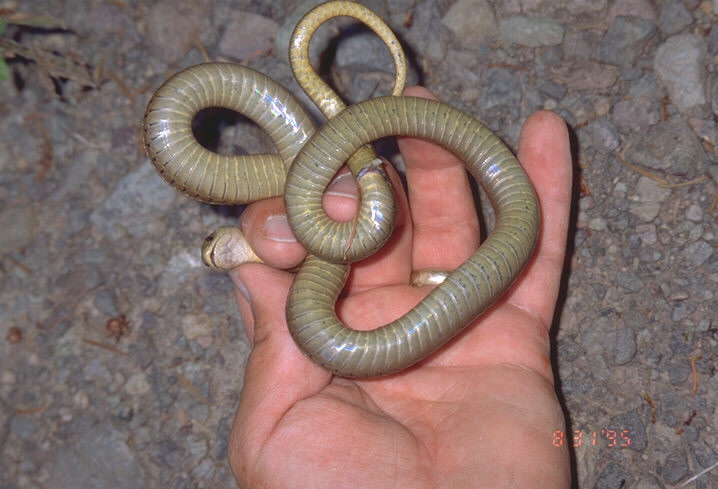
This individual shows a plain underside, in contrast to those that show red spotting underneath.
Photographed by Matthew G. Hunter ..... Date: 8/31/95 ..... Photo: AAG-080
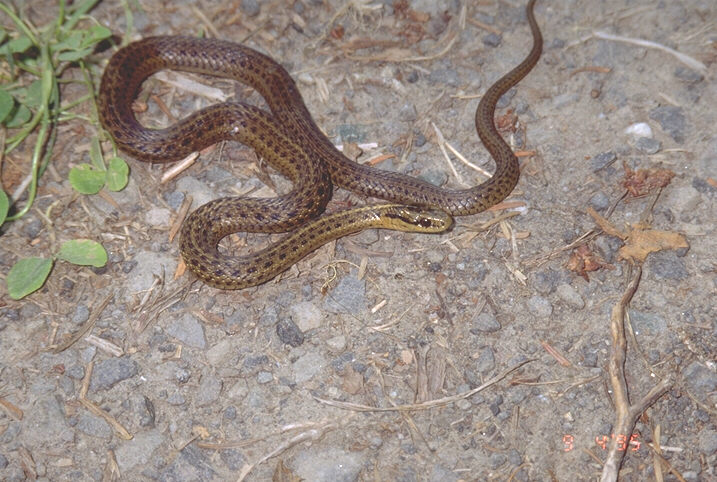
This individual shows larger spots combined with some dull striping, and a dark line behind the eye.
Photographed by Matthew G. Hunter ..... Date: 9/14/95 ..... Photo: AAG-081

This lizard is most common at lower elevations, in relatively hot, dry areas that have little or no tree cover. Common locations are sunny slopes around reservoirs or rivers, rock outcrops and quarries, hot sunny clearcuts, and log landings with logs remaining to provide vertical structure and hunting areas.
Photographed by Lisa L. Hunter ..... Date: 6/29/95 ..... Photo: AAG-082
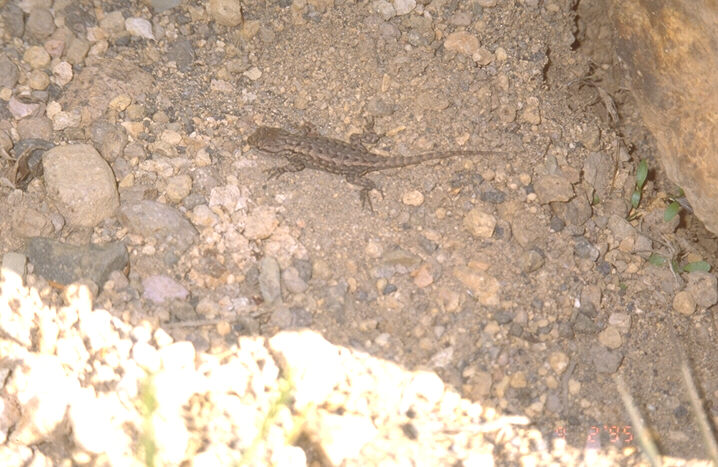
Photographed by Matthew G. Hunter ..... Date: 9/2/95 ..... Photo: AAG-083

Rarely seen except when in hand, these lizards have impressive coloration underneath.
Photographed by Matthew G. Hunter ..... Date: 9/13/95 ..... Photo: AAG-084
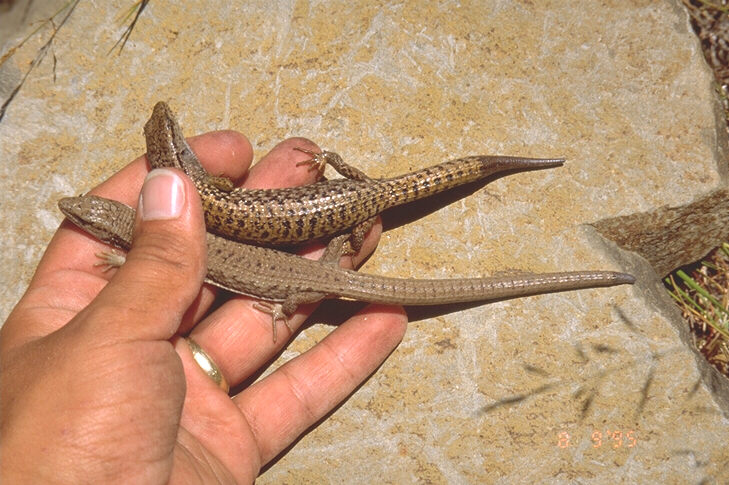
This photo and the next show what might be a mated pair of lizards showing noticable differences in degree of pigmentation.
Photographed by Matthew G. Hunter ..... Date: 8/9/95 ..... Photo: AAG-085

The undersides of these two lizards show striking differences in pigmentation.
Photographed by Matthew G. Hunter ..... Date: 8/9/95 ..... Photo: AAG-086

The variegated pattern on the upper parts of this lizard blend well with diverse background. Aptly called the alligator lizard, this species does not hesitate to bite an unsuspecting captor. The bite is usually more startling than damaging, except when a larger lizard is involved.
Photographed by Matthew G. Hunter ..... Date: 8/9/95 ..... Photo: AAG-087

Photographed by Matthew G. Hunter ..... Date: 8/18/95 ..... Photo: AAG-088
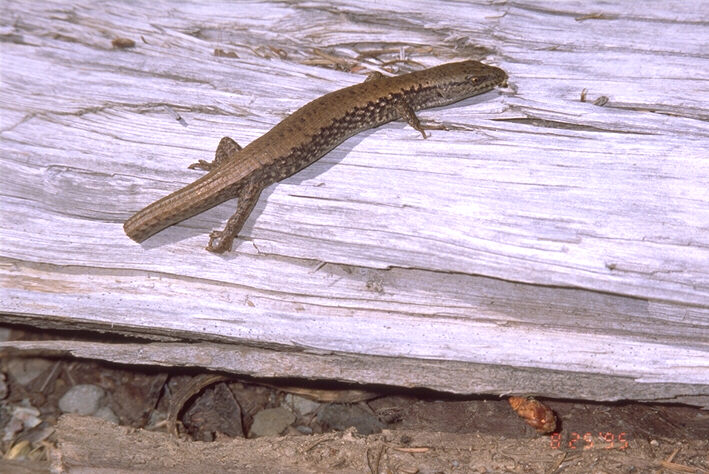
Photographed by Matthew G. Hunter ..... Date: 8/25/95 ..... Photo: AAG-089
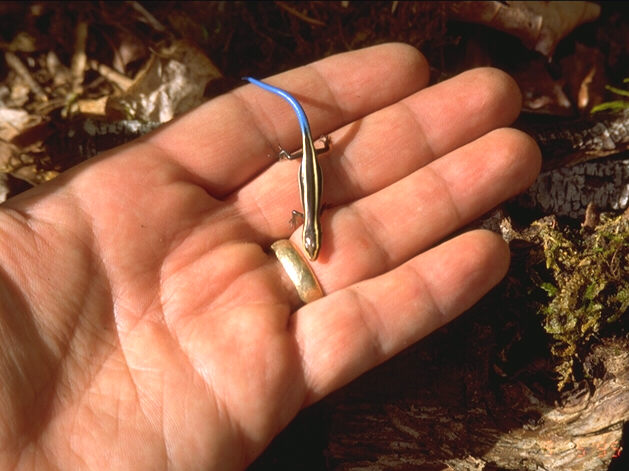
This is a rather small individual, hatched from an egg probably less than three months previous. Adults get to about three times the length of this one.
Photographed by Matthew G. Hunter ..... Date: 9/5/95 ..... Photo: AAG-090

Photographed by Matthew G. Hunter ..... Date: 8/26/95 ..... Photo: AAG-091

Photographed by Matthew G. Hunter ..... Date: 7/18/95 ..... Photo: AAG-092
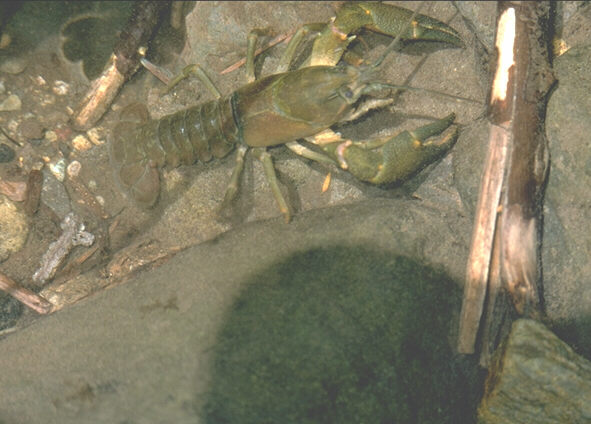
Photographed by Matthew G. Hunter ..... Date: 6/27/95 ..... Photo: AAG-093
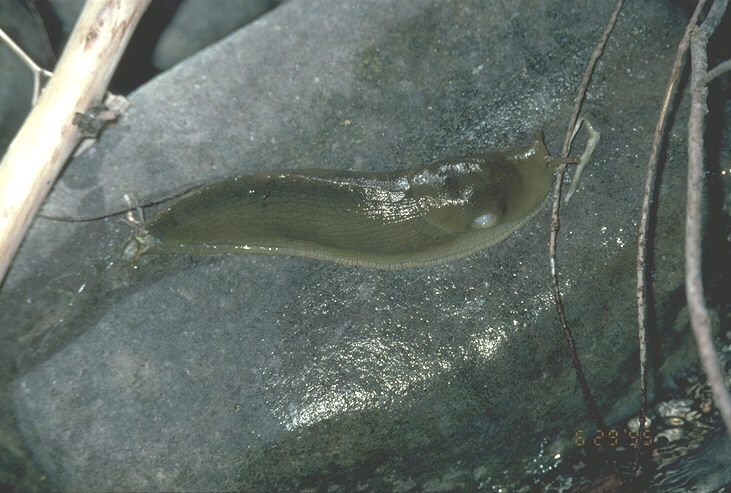
Photographed by Matthew G. Hunter ..... Date: 6/29/95 ..... Photo: AAG-094

Photographed by Matthew G. Hunter ..... Date: 8/19/95 ..... Photo: AAG-095
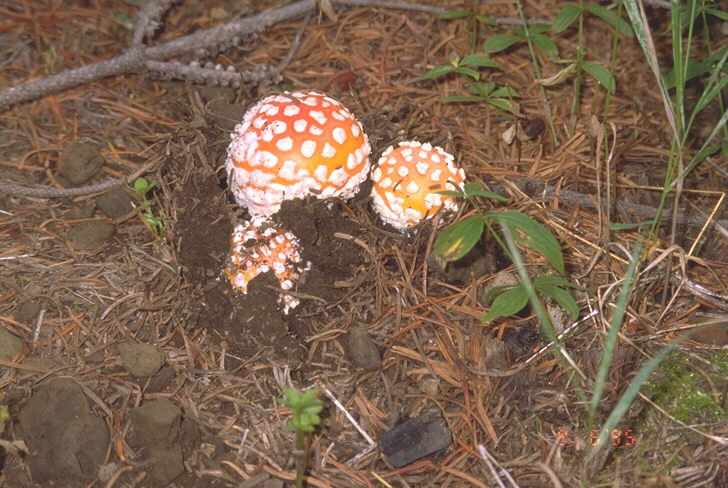
Photographed by Matthew G. Hunter ..... Date: 9/6/95 ..... Photo: AAG-096

Photographed by Matthew G. Hunter ..... Date: 8/8/95 ..... Photo: AAG-097

Photographed by Matthew G. Hunter ..... Date: 8/24/95 ..... Photo: AAG-098
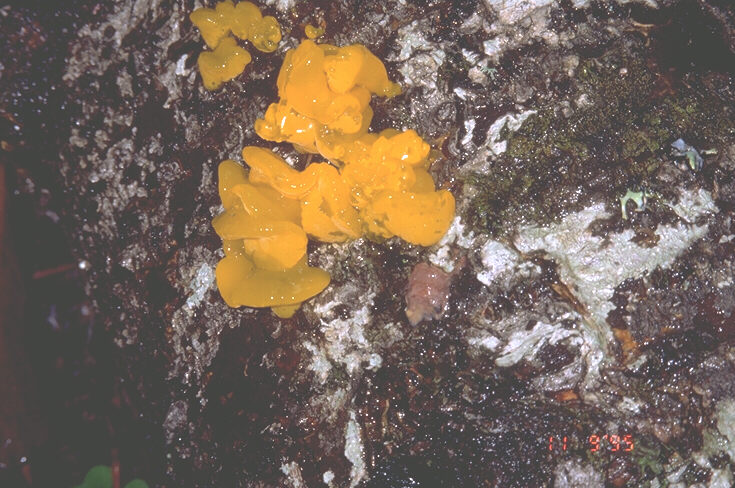
Photographed by Matthew G. Hunter ..... Date: 11/9/95 ..... Photo: AAG-099
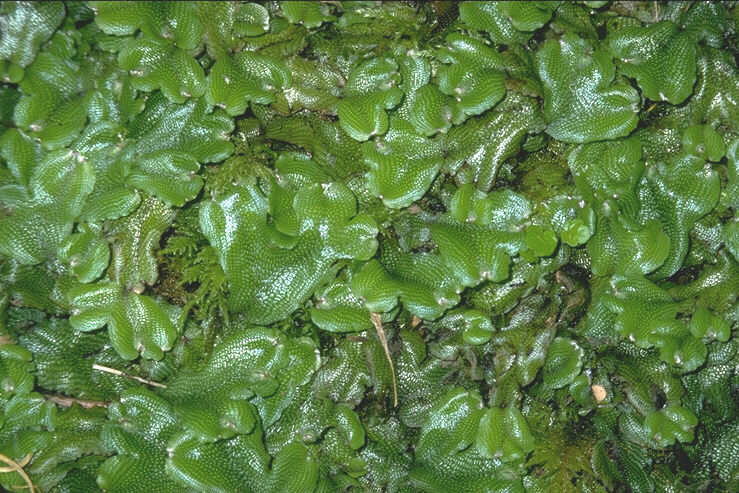
Photographed by Matthew G. Hunter ..... Date: 6/24/95 ..... Photo: AAG-100